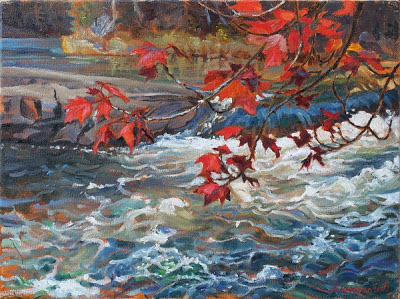After The Flood, St John River (oil on canvas, 5 x 7 in.)
14 June finds me standing by the broad St John River west of Jemseg, painting a Silver Maple with its evening reflection as the flood levels of a rainy week begin to recede. Fred is searching the skim of filtered drift over packed grass for the places where there are the most snail shells. Robert Forsyth is searching the ground above the flood line for living snails, and Owen is botanizing, taking special note of Winterberry Holly, invasive Angelica sylvestris, and a
young Basswood resprouting after the brush cutting of road maintenance. This is at the eastern limit of the range of the Basswood.
young Basswood resprouting after the brush cutting of road maintenance. This is at the eastern limit of the range of the Basswood.
The St John River is wide here, sandy bottomed and nearly tidal, along Hwy 105, near the bridge of Highway 2. Strands of drifted grass trail from lower branches and reflect against the sunset sky. In the shallows at the bottom of my painting, short bright spears of spring grass and new fronds of Sensitive Fern emerge from the dark water,
The highways here travel on bars or causeways, and the St John River is broad and complex, with large wet meadows that now look like a vast lake riddled with grassy islands. Billowing green rows and groves of Soft (Red and Silver) Maples pattern the wetland, look ing like ordinary forests, but now most stand in black water, shading banks of lime green Sensitive Fern.
Red and Silver Maple are the "Soft Maples", with softer wood than Sugar Maple. They hybridize extensively in the wild in certain areas. Owen says that many of the so-called "Silver Maples" here look to have some Red Maple ancestry. The hybrid is called "Freeman Maple".
This is our first day at the New Brunswick Museum's Bio-blitz of Grand Lake Meadows near Gagetown. Having settled our trailer and tent at the lab facilities we drove out around the wetland and over the bridge, a unavoidable circuit of 20 kilometres, to access the Protected Natural Area, only 6 kilometres distant from our Bio-blitz headquarters.
The locals tell us that the water levels were recently 2 metres above normal after days of torrential rains associated with Tropical Storm Andrea. This has now fallen 40-60 cm below the recent crest. The Bio-blitz is equipped with one aluminum boat and two zodiacs, but due to high water levels it will be interesting to see how much wetland work will be possible, as normal wetland flora and fauna will be inundated and dispersed, and the shorelines are quite shifted to areas that are usually higher ground. We can't find mussel shells because the banks are inundated, but our Coleopterist Reggie Webster, is collecting lots of tiny beetles that have been concentrated at the water's edge, driven from their normal habitat.
Fred and I drove through this area last August on our way to the Caledonia Gorge Bio-blitz navigating by map at night to a perfect parking spot beneath the Highway 2 bridge. This happens to be very close to where I am painting this evening, and within the Protected Natural Area of this year's New Brunswick Museum Bio-blitz, Grand Lake Meadows. I feel like I've come full circle.
Dear patrons and supporters,
This painting was done at the New Brunswick Museum Bio-blitz, held in the Grand Lake Meadows Protected Natural Area near Fredericton, New Brunswick. The price is $275. If you would like to purchase it, please contact me.




This painting is SO beautiful, Aleta. I'm sure it will be sold immediately, or, as my mother used to say "immediately if not sooner"!
ReplyDeleteK
I love the reflections.
ReplyDelete